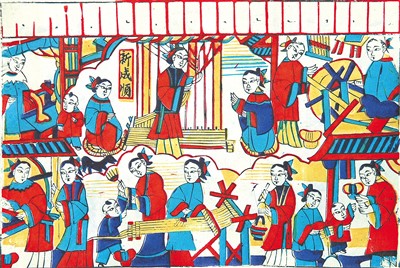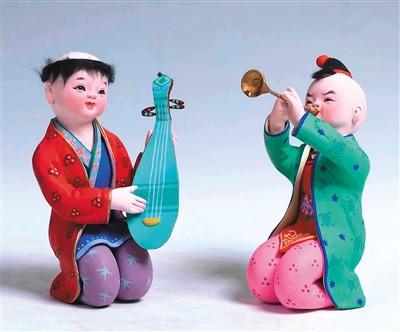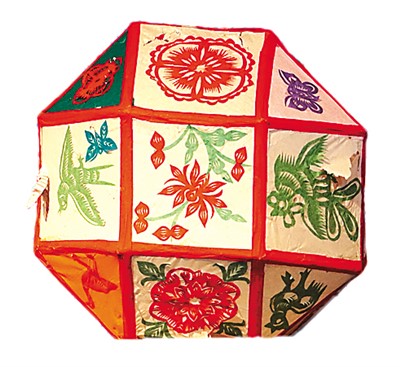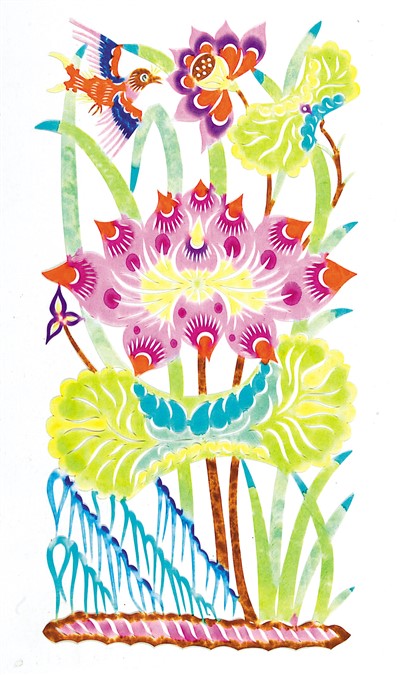 |
"Ten Busy Women", Yangjiabu New Year picture, Weifang, Shandong
Shandong Institute of Arts and Crafts Museum |
 |
The Joy of Spring Festival, a clay sculpture in Huishan, Wuxi, Jiangsu, Gong Qi
Collection of Chinese Art Museum |
 |
festive lantern
Shandong Institute of Arts and Crafts Museum |
 |
Hebei Sanhe paper-cut "Little Bird Lotus" Zhao Jing'an
Collection of Chinese Art Museum |
The Spring Festival is the most grand traditional festival of the Chinese nation. In the long agricultural civilization, the ancient Chinese took the first harvest of millet as a "year", and the sowing and harvesting cycle of grains also became the rhythm of people's life. Spring birth, summer growth, autumn harvest, and winter storage. At the end of the year, winter goes to spring again. While celebrating the harvest, a new round of sowing and harvesting is also welcomed. A series of grand and festive folk activities have been formed for this purpose, such as worshiping the heaven and ancestors, praying for good fortune, feasting and entertainment, bidding farewell to the old and welcoming the new.
The Spring Festival of the Chinese nation is not just a carnival, but also includes ritual activities and their connotations such as ancestor worship, keeping watch, praying for blessings, and reunion, so as to constantly build the relationship between each individual and their departed ancestors, past history, vast nature, endless flowing time, relatives and friends, and constantly look forward to and fill the vision and hope of real life, Constantly express and realize the pursuit of goodness and beauty. All these are spiritual, practical, and often tangible. They are expressed in the form of art and further condensed and sublimated in aesthetics.
Just as in the tradition of the Spring Festival, since childhood, people have started various preparations for "busy New Year", such as dusting, purchasing New Year goods, steaming steamed buns, posting New Year pictures, Spring Festival couplets, "Fu" characters, window decorations, etc. As the Tianjin saying goes, girls need flowers, boys need guns, and old people need felt hats. The Spring Festival is a celebration, a renewal and a pursuit of beauty. When the Lunar New Year comes, people will put on a "clean offering", go to temple fairs, walk flower streets, play social fireworks, dance lions and dragons, watch lanterns, express their feelings, place their wishes, feel joy and joy, and express their yearning for a better life in a vivid form and immersive experience. In this sense, the Spring Festival is not only a folk custom, but also an artistic and aesthetic one. The art of the Spring Festival is the creation and experience of beauty by the folk, the public and the national collective. It is a process that all people participate in personally.
If the rich and colorful folk arts of the Spring Festival are divided, they generally include the art of praying for good fortune, the art of home decoration, the art of feasting and communication, and the art of entertainment. The artistic presentation, decorative aesthetics, and entertainment experience involving the cultural ceremony and meaning of the Spring Festival are also often intertwined. While expressing the meaning of the Spring Festival, the decorative space Decorate the atmosphere.
First of all, in the traditional Spring Festival, every household posted door gods, New Year pictures, the word "Fu", window grilles, door notes, couplets, etc., which is the "pupil day of thousands of households", and it is a festive occasion. North Shaanxi believes in the sky and sings songs. During the Spring Festival, people visit the door and the door. "One look at the window and the second look at the curtain". The Spring Festival couplets on the door and the tracery on the window show the spirit of a family. There are also door gods, New Year pictures, "Fu" characters, door lettering, etc. The color tone is mostly red hot, the color matching is often gorgeous and strong, and the image and pattern are most familiar to the people, bright and even exaggerated, often have a look, a speech, powerful words, and a play in the painting, which makes people feel bored. Jirui's words, hearty calligraphy, majestic statues and the picture of ideal life such as good weather, peaceful country, happy family, happy life and tranquility express people's good wishes and sustenance, and also become the social enlightenment and spiritual inspiration of kindness and beauty. It is worth mentioning that these folk paintings and paper-cut not only pay attention to "knowing people, things and times" in their creation to express the interests and pursuit of the masses, but also meet the needs of traditional home environment decoration. For example, the door gods include the door gods of houses, houses and streets; New Year pictures include door pictures on the door, stove pictures on the stove wall, four screens on the bedroom wall, kang paintings on the wall of kang, table wall, and window top, table paintings, window paintings, and happy pictures; The word "Fu" also has the word "Fu" on the gate, and the word "Fu" on the water tank, cabinet, and barn door; The exquisite paper-cut not only has window flower, but also ceiling flower, lantern flower, offering flower, etc... It is decorated with all kinds of decorations, making the day colorful.
In addition to the art and decoration used for posting, the traditional home decoration art in the Spring Festival also includes "clear offerings during the year", which means placing objects for viewing on the indoor desk, including seasonal fruits, flower bonsai, antiques and stones, etc. As the saying goes, "There is nothing else to do on the New Year's Eve in the mountain family. If you insert plum blossoms, you will be in the year", or as the scholar Wang Zengqi said, even if peonies and plum blossoms are not easy to get, raising a pot of green garlic instead of daffodils should have a little color. Whether rich and elegant or simple and fresh, the decoration of the Spring Festival is festive, eye-catching and full of hope.
In terms of diet, ancestral worship, New Year's Eve celebration, New Year's Eve dinner, eating annual food, etc., which are more abundant than usual, are not only a rich experience of the diet itself, but also contain rich and beautiful meanings, and often rise from the beauty of food shape and taste to the beauty of spirit and emotion. For example, Laba combines grains, grains, porridge, and presents porridge to neighbors, relatives, and friends. This custom of cherishing things and giving gifts and sharing goes beyond the taste of porridge and rice, and enters a ritual experience of cultural spirit. Another example is Jiaodong, Shandong Province. Since the beginning of the traditional Spring Festival, every family has begun to steam dates, bake cakes, and make longevity peaches. They make all kinds of noodles with auspicious meanings and vivid shapes. They are not only part of the festival diet, but also used as gifts and offerings. From the beauty of food to emotional exchanges, they become a spiritual resonance. Artist Zhang Ding once recalled: "I remember spending the old calendar year in my hometown when I was a child... At that time, my most satisfied job was that my mother adjusted a rouge cotton plate, used a chopstick, stained with rouge, and hit red dots on the new steamed buns one by one", round red dots, and touched the atmosphere of the New Year. If nothing else, "It seems to be barren, lacking something, not like the New Year.". This "beauty of a little" is a beautiful realm of life.
During the Spring Festival, there are also colorful recreational activities. As the saying goes, "The common people should be happy. They should go to the party, sing operas, and hold the festival fire." Folk arts such as stilts, lion and dragon dances, and drum and yangko are gathered in the festival fire and flower show. The spontaneous performances of urban and rural people are lifelike. The crowds watching the interaction are like mountains and seas. The cheerful drum music is more and more vigorous. The makeup or mask of the performance is often full of strong local flavor, Together, they form a lively festival celebration. In addition, from New Year's Eve to the 15th day of the first lunar month, shops and people often hang red lanterns in many towns and villages. "The lanterns are high, the lanterns are low, and the Yangge is played under the lanterns." In the villages of northern Shaanxi, on the 15th night of the first lunar month, the nine curves of the Yellow River turn into a lantern array; In the Yunnan Guizhou Plateau, the bonfire singing and dancing of ethnic minorities are flourishing... The lights and singing and dancing are intertwined, expressing the sincere and simple feelings of the Chinese nation.
Through the ages, the Chinese nation has moved from tradition to modernity, from agricultural civilization to industrial civilization and information civilization. The Spring Festival ceremony has changed to varying degrees, but it is still grand and grand. The art and aesthetics of the Spring Festival are still innovative in inheritance, and also warm and profound. Today, thousands of miles home for the Spring Festival, Spring Festival travel has become a cultural phenomenon; The "national trend" of cultural creation and clothing in the Spring Festival is surging, and Chinese red, auspicious patterns and zodiac images have become the elements of the trend; The traditional New Year etiquette, singing, dancing and entertainment are also breaking through the circle, becoming the "national style" feature, and generating new resonance in the new intergenerational crowd.
The mountains and rivers are far and wide, and the world is full of stars. The Spring Festival is the cultural vein of the Chinese nation for thousands of years, accumulating and inheriting the strength and pursuit of life. The Spring Festival in folk art goes through history, transcends material, and shows the ideal and significance of life in the pursuit of beauty, kindness and happiness.
(The author is a professor of Shandong Institute of Arts and Crafts)
(Editor in charge: Wang Lianxiang, Li Nanhua)
Share to let more people see








































